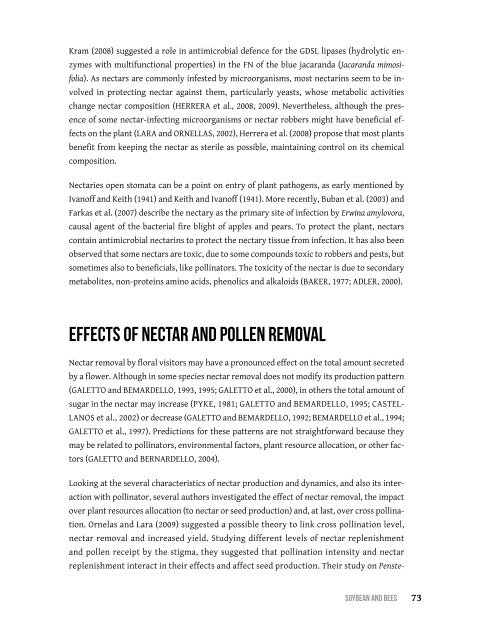Soybean and Bees
You also want an ePaper? Increase the reach of your titles
YUMPU automatically turns print PDFs into web optimized ePapers that Google loves.
Kram (2008) suggested a role in antimicrobial defence for the GDSL lipases (hydrolytic enzymes<br />
with multifunctional properties) in the FN of the blue jacar<strong>and</strong>a (Jacar<strong>and</strong>a mimosifolia).<br />
As nectars are commonly infested by microorganisms, most nectarins seem to be involved<br />
in protecting nectar against them, particularly yeasts, whose metabolic activities<br />
change nectar composition (Herrera et al., 2008, 2009). Nevertheless, although the presence<br />
of some nectar-infecting microorganisms or nectar robbers might have beneficial effects<br />
on the plant (Lara <strong>and</strong> Ornellas, 2002), Herrera et al. (2008) propose that most plants<br />
benefit from keeping the nectar as sterile as possible, maintaining control on its chemical<br />
composition.<br />
Nectaries open stomata can be a point on entry of plant pathogens, as early mentioned by<br />
Ivanoff <strong>and</strong> Keith (1941) <strong>and</strong> Keith <strong>and</strong> Ivanoff (1941). More recently, Buban et al. (2003) <strong>and</strong><br />
Farkas et al. (2007) describe the nectary as the primary site of infection by Erwina amylovora,<br />
causal agent of the bacterial fire blight of apples <strong>and</strong> pears. To protect the plant, nectars<br />
contain antimicrobial nectarins to protect the nectary tissue from infection. It has also been<br />
observed that some nectars are toxic, due to some compounds toxic to robbers <strong>and</strong> pests, but<br />
sometimes also to beneficials, like pollinators. The toxicity of the nectar is due to secondary<br />
metabolites, non-proteins amino acids, phenolics <strong>and</strong> alkaloids (Baker, 1977; Adler, 2000).<br />
Effects of nectar <strong>and</strong> pollen removal<br />
Nectar removal by floral visitors may have a pronounced effect on the total amount secreted<br />
by a flower. Although in some species nectar removal does not modify its production pattern<br />
(Galetto <strong>and</strong> Bemardello, 1993, 1995; Galetto et al., 2000), in others the total amount of<br />
sugar in the nectar may increase (Pyke, 1981; Galetto <strong>and</strong> Bemardello, 1995; Castellanos<br />
et al., 2002) or decrease (Galetto <strong>and</strong> Bemardello, 1992; Bemardello et al., 1994;<br />
Galetto et al., 1997). Predictions for these patterns are not straightforward because they<br />
may be related to pollinators, environmental factors, plant resource allocation, or other factors<br />
(Galetto <strong>and</strong> Bernardello, 2004).<br />
Looking at the several characteristics of nectar production <strong>and</strong> dynamics, <strong>and</strong> also its interaction<br />
with pollinator, several authors investigated the effect of nectar removal, the impact<br />
over plant resources allocation (to nectar or seed production) <strong>and</strong>, at last, over cross pollination.<br />
Ornelas <strong>and</strong> Lara (2009) suggested a possible theory to link cross pollination level,<br />
nectar removal <strong>and</strong> increased yield. Studying different levels of nectar replenishment<br />
<strong>and</strong> pollen receipt by the stigma, they suggested that pollination intensity <strong>and</strong> nectar<br />
replenishment interact in their effects <strong>and</strong> affect seed production. Their study on Penste-<br />
SoybeAn <strong>and</strong> bees<br />
73


